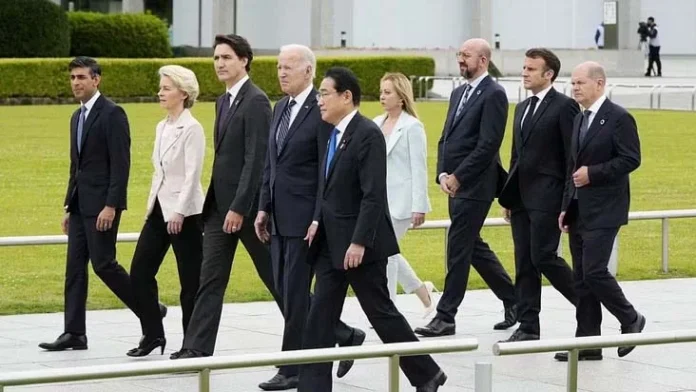Beijing, which was once again ignored by the G-7 for its annual meet, organised first in-person summit with five Central Asian countries during the same time-frame the G-7 leaders held a summit in Hiroshima; it was seen pushing “Chinese path” of the world development agenda at the summit in Xian. All this while, the G-7 meet was used by developed countries to highlight the Ukraine war and in sending a message to China that it has emerged as “the greatest challenge” for global security and prosperity.
For India, which was represented by Prime Minister Narendra Modi at the G-7 Summit, it was an opportunity to personally interact with Ukrainian President Volodymyr Zelenskyy on the sidelines of the summit and express its support for dialogue and diplomacy to find a way forward to resolution of more than one-year-old conflict. At the summit, India dwelled on UN reforms, problems faced by the countries of the Global South due to the Ukraine war, climate change and food security.
But what a strange way to flex influence at the international level by China! While G-7 countries and special invitees at the summit in Hiroshima were mulling over situation in Indo-Pacific, ongoing conflict in Ukraine, nuclear disarmament, economic security and clean and renewable energy, China, at the first ever in-person summit with five Central Asian countries on May 18-19 in Xian, was talking about greater political and economic partnership between the two sides.
In the presence of Heads of State of Kazakhstan, Kyrgyzstan, Tajikistan, Turkmenistan and Uzbekistan, Chinese President Xi Jinping, as per Reuters, unveiled a grand plan for Central Asia’s development—from building infrastructure to boosting trade with the region.
The Chinese President pledged 26 billion yuan ($3.7 billion) in fresh loans and grants to the resource-rich Central Asian countries for development of infrastructure during the summit. As per China’s Foreign Ministry, Beijing will build a regional logistics network, step up the development of China-Europe Railway Express assembly centres, expedite the construction of Line D of the China-Central Asia Gas Pipeline, build overseas warehouses in Central Asian countries and a comprehensive digital service platform.
All this is seen as China’s effort to give a fresh boost to the Belt and Road Initiative in the Central Asian countries, which has become the very basis of pushing the region towards crippling debt. Till 2022, investment between China and five Central Asian countries reached a record high of more than $70 billion dollars, said Reuters. The international news agency further said that Chinese loans under BRI to Kyrgyzstan and Tajikistan account for more than fifth of their GDP. While China’s loans to Turkmenistan and Uzbekistan account for more than 16% of their GDPs and Kazakhstan over 7% of its GDP, the New York Based-National Bureau of Economic Research said in its recent report.
Between 2005 and 2020, China invested $19.2 billion in Kazakhstan. As part of BRI projects, China is involved in the development of East-West infrastructure projects across the Central Asian country, said Nikkei Asia. This apart, China is investing $24.5 billion on 56 projects, which include development of rail linkages, airports, roads, and power and are expected to be completed by 2023-24.
Tajikistan, which joined the BRI in 2018, owed $3.3 billion to international creditors by 2022. Of this total, Dushanbe owed 60% of debt to the Export-Import Bank of China. From 2020 and 2021, the Central Asian country borrowed $1,021.5 million from China to complete 44 projects, ranging from roads, railways and pipelines to thermal power plants, industrial zones. Tajikistan’s new parliament building, city hall in Dushanbe, and the Free Economic Zone in Danghara are important BRI projects.
Tajikistan started securing loans from China in 2007 and by the end of 2008, Beijing emerged as one of the largest creditors of the Central Asian country. In 2009, 77% of Tajikistan’s loan portfolio consisted of Chinese loans, said the Central Asian Bureau for Analytical Reporting, a wing of the US-based Institute of War & Peace Reporting. In 2011, China took away 1,158 square kilometres of Tajik territory after the country failed to repay outstanding loans to Beijing.
On the other hand, Kyrgyzstan which shares a more than 1000 km long border with China is under the octopus grip of debt-trap BRI programme. The BRI corridor that connects China with West Asia and Europe, passes through Kyrgyzstan. Besides, China-Kyrgyz-Uzbekistan (CKU) railway and Turkmenistan-China gas pipeline are important BRI projects passing through Kyrgyzstan. In 2022, Kyrgyzstan’s GDP was under $9 billion. But the construction of the CKU railway alone will be around $5 billion, said a report by Silk Road Briefing.
Till 2019, the total Kyrgyzstan’s external debt amounted to $5 billion (424 billion KGS) and 40% of it ($1.8 billion) belonged to the Export-Import Bank of China for the series of projects under the controversial BRI programme. Since 2008, Kyrgyzstan received nine large loans from China; six to build or repair roads and three to build or modernise power facilities.
In early 2018, China renovated Bishkek’s main power plant that stopped working when Kyrgyzstan was freezing at -20 temperature. In February 2021, questions were raised in Kyrgyzstan’s parliament over the plant’s huge reconstruction cost–$386 million and its continued shortfalls in production.
This development took place weeks after anti-China sentiment in Kyrgyzstan took a toll on Chinese interests with business and Chinese people coming under attacks and angered Beijing summoning Kyrgyz Ambassador to China, Kanayyam Baktygulova to express its displeasure. In 2020, the Kyrgyzstan government cancelled a $275 million Chinese investment project after a series of protests.
But Turkmenistan continues to latch on to China for investment and trade. The Central Asian country serves as a key strategic location for China’s expanding businesses and trans-continental connectivity programme under BRI. The key BRI infrastructure in Turkmenistan is the 3,666 km long Turkmenistan-China Gas Pipeline which delivers around 80% of gas to China.
In 2021, Turkmenistan President Gurbanguly Berdymukhamedov announced that Ashgabat paid off loans provided by China for the pipeline on time and in full. AFP quoted ex-President of China Development Bank Jiang Chaoling as saying that the bank had loaned $8.1 billion to Turkmenistan for its gas pipeline project.
Analysts suspect the truth of the announcement in view of the quantum of Chinese loans and their terms and conditions for the payment. Moreover, what make analysts to question the truth of the announcement is that in 2021 itself, President Berdymukhamedov had made a rare admission of economic failure, telling his government to consider asking creditors to prolong periods for debt repayments, said the AFP report, published by Asia Financial on June 12, 2021.
By 2022, Chinese investment, as per Global Times, in Uzbekistan exceeded $10 billion. Already reeling under huge foreign debt, Uzbekistan and China signed deals worth $16 billion, during Chinese President Xi Jinping’s visit to Samarkand to attend the Shanghai Cooperation Organisation summit on September 15-16, 2022, said Asia Times. The deals included the construction of the China-Kyrgyzstan-Uzbekistan railway. Under the BRI programme, China has built a tunnel in Uzbekistan through which passes the Angren-Pap railway line. The tunnel is considered as the longest tunnel in Central Asia. Much talked about China-Kyrgyzstan-Uzbekistan highway is built under the BRI programme.
With Russia involved in war with Ukraine and the US presence in the region completely diminished following the withdrawal of US troops from Afghanistan in August 2021, China found it a right time to advance BRI programme and influence in the Central Asian region by conducting the first China-Central Asia summit in-person.
Analysts say key interests of China in the region is to secure its energy security, strategic and territorial interests. But then while Beijing has a joyride across Central Asia, the same is not with the countries of the region. They face challenges in managing their nationals’ anger against China for its treatment of Muslim minority in Xinjiang and predatory policies. Yet ground realities force them to overlook their nationals’ anger and cozy up to China for trade and investment.
–The writer is a senior journalist with wide experience in covering international affairs. The views expressed are of the writer and do not necessarily reflect the views of Raksha Anirveda
–The writer is a senior journalist with wide experience in covering international affairs. The views expressed are of the writer and do not necessarily reflect the views of Raksha Anirveda






